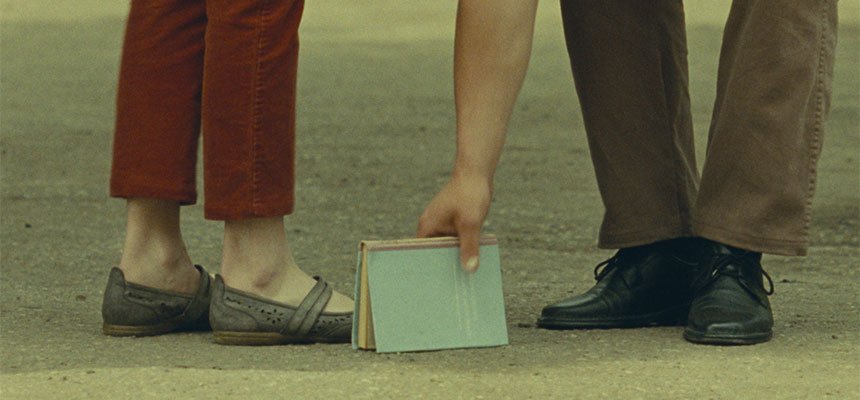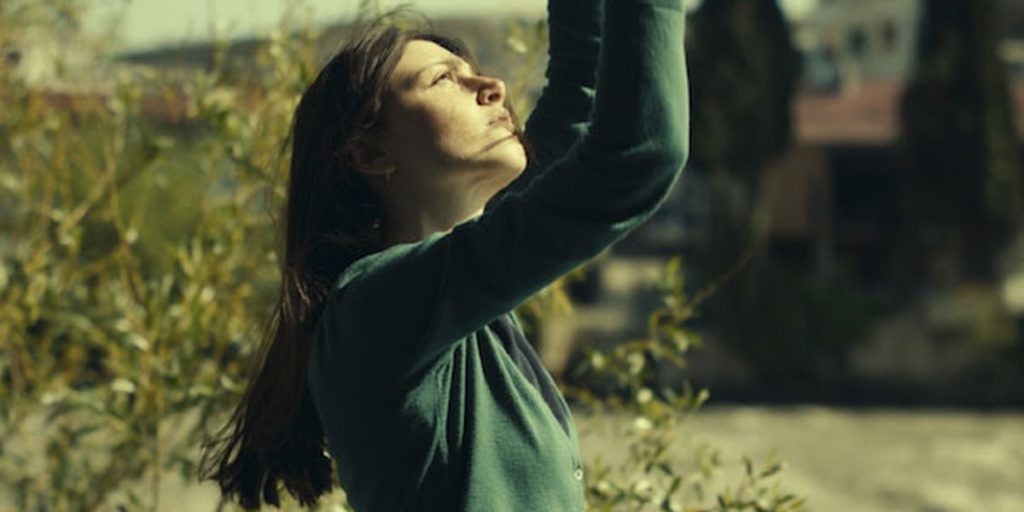What Do We See When We Look at the Sky? is a journey of love and metamorphosis that is unique because of its focus on everyone but its main characters.
In Kutaisi, Georgia, pharmacist Lisa (Oliko Barbakadze) and football player Giorgi (Giorgi Ambroladze) meet when they bump into each other. After another accidental meeting, the two agree to meet the next day at an outdoor café. But as Lisa heads home, surveillance cameras, rain gutters and even the wind tell her about a curse that will change her appearance. Sure enough, the next morning, Lisa has a completely new body (from here, she is played by Ani Karseladze). However, Lisa is unaware of two important details. The first is that Giorgi (now played by Giorgi Bochorishvili) will also wake up changed as well. The second is the couple’s respective skills in medicine and football have disappeared. It is as if they have become completely different people.
From there, Lisa and Giorgi try to cope with the stark alterations to their lives. Predictably, they miss their date despite both being there at the same time. Yet, in an unbelievable stroke of luck, they both get jobs with the café owner (Vakhtang Fanchulidze) planning for the start of the World Cup. But they still fail to meet and are still oblivious to who the other person is despite being nearby. Meanwhile, the film takes a deep look at the world Lisa and Giorgi inhabit, whether the scenes showcase children playing football near Giorgi’s apartment or a group who runs a bakery in the hills of Kutaisi.
Premiering at last year’s Berlin Film Festival, What Do We See When We Look At The Sky? comes to us from Georgian director, writer and editor Alexandre Koberidze (he also voices the self-referential narration). It is a tale of love, metamorphosis and failing to recognise your soulmate, like a classical Greek tragedy. However, for a film whose story revolves around appearances and human features, it surprisingly keeps us at an emotional and physical distance. Lisa and Giorgi’s first meeting is shot from the waist down, gazing at their feet. Their second is from afar, providing a better view of the town than the couple. Maybe Koberidze is saving the looks at the couple until after their transformation. Except, when that happens, their responses are off-screen. Giorgi’s reaction to not being recognised by his football coach goes unseen because he is behind a tree.

As it turns out, this emotionally intimate story – one that concerns the fear of change and not being recognised by those closest to you – is being told as widely as possible. The cinematography from Faraz Fesharaki is warm and summery, matching the timeframe of the narrative (based on the concurrent World Cup tournament, the film probably takes place between June and early July). Medium and long shots give us panoramas of the Georgian surroundings, the daytime views and quiet nightscapes. And when Lisa or Giorgi are filmed, there is heaps of space around them. The way the film is shot is a deconstruction of what we expect from a story like this, who we expect to follow.
So, who does Koberidze focus on? One scene near the end of What Do We See When We Look At The Sky? gives us the answer. In it, Giorgi leaves his apartment and the camera pans to follow him. But it then stops at a group of boys who are painting ‘Messi 10’ on their backs with orange paint. It may only be for a brief moment, but it perfectly sums up the emphasis on the small slices of Georgian life. There are coincidences in the film that dictate Lisa and Giorgi’s love story; however, the biggest are the glances at other lives.
On the surface, they seem like non-sequiturs that distract from the narrative. Nonetheless, these small scenes are what makes this film unique. The children playing outside. The kids skipping school to get ice cream at the café. The rural bakery with various stations en plein air. The café owner trying to set up an outdoor screen ahead of the World Cup. The stray dogs who are friends yet wander to different bars to watch the football (as explained in great detail by the narrator). At one point, the film suddenly starts depicting a director and cameraperson who are trying to find six couples in love for their project. It is inexplicable but also perfectly in keeping with Koberidze’s interest in the world around Lisa and Giorgi instead of exclusively them.
The ultimate compliment you can give to What Do We See When We Look at the Sky? is that it feels like you have gone on a massive journey by the end. The editing relies on fades, dissolves and montages, with the latter used to link seemingly disconnected people and landscapes. The score from the director’s brother Giorgi alternates between orchestral, discordant and a sound similar to that of a silent film. And a great screenplay from Koberidze means that even if the narrative takes a back seat at times, the storytelling is still compelling. Watching Lisa and Giorgi meet all over again, about to eat Khachapuritogether before being interrupted, is weirdly spellbinding.
Despite these technical achievements, the strongest aspect of the film might be its ending. It is cathartic yet hints at Lisa and Giorgi’s romance becoming what the narrator describes as one of “the countless, no less exciting adventures that happen every day”. The point of the film is to show that these adventures and stories happen all around us. Something mythic happened to our main characters, but their story is only important because it was selected by Koberidze. And that becomes a comment on how filmmakers choose their stories. It is a stroke of genius that summarises What Do We See When We Look At The Sky? pretty well. It is a mysterious, inquisitive and intriguing movie even when it does not focus on its main characters.
What Do We See When We Look At The Sky? is now available to watch on MUBI, on digital and on demand in North America. The film will be released theatrically in the UK on November 25, 2022.

